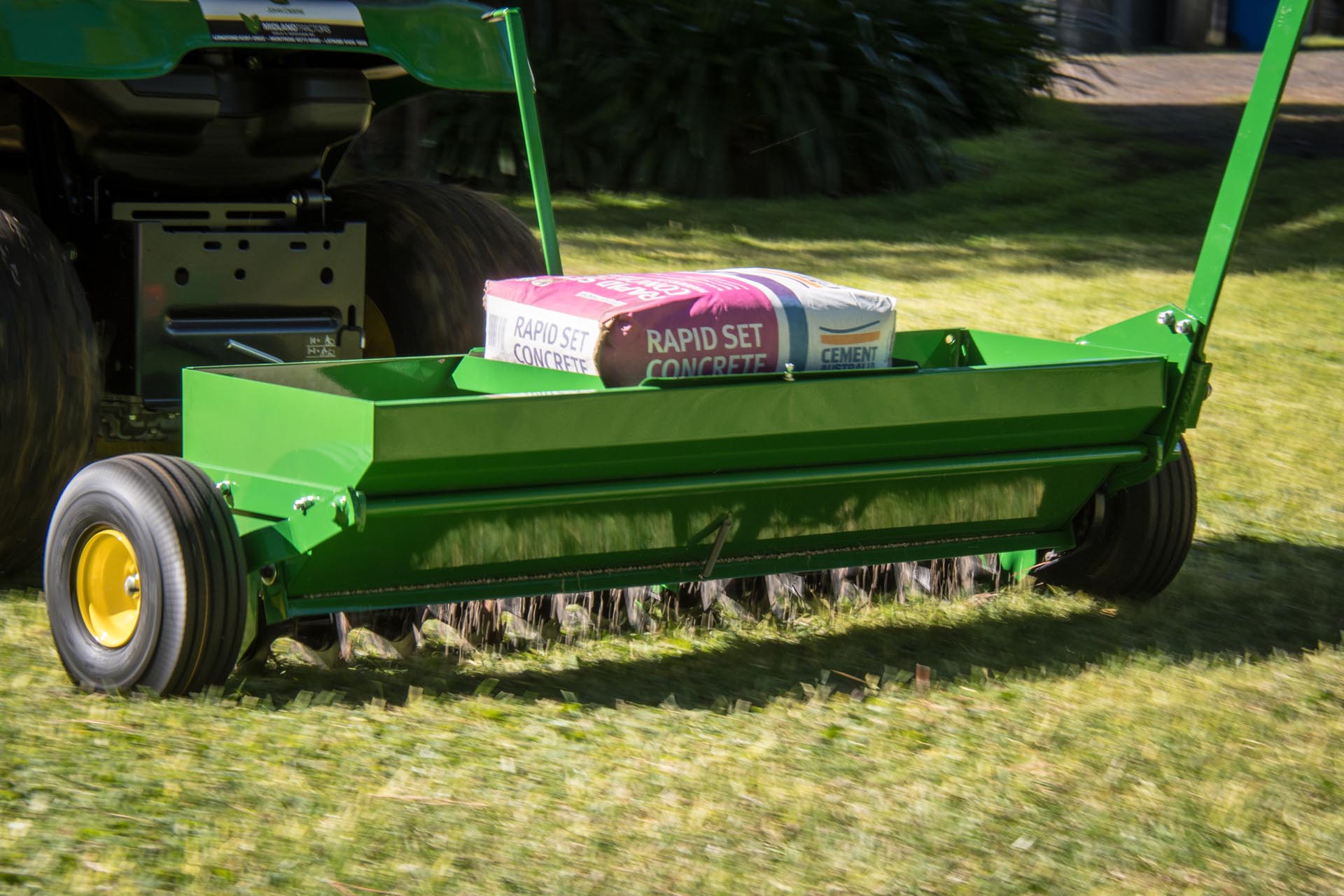John Deere’s tow behind 40-inch aerator-spreader is certainly a handy addition for serious lawn care professionals. Its ability to be quick hitched behind a variety of machines combined with adjustable soil depth penetration and spreading rate add to its versatility as Howard Shanks discovered.

John Deere 40-Inch Aerator-Spreader
The 40-inch (102cm) tow behind aerator-spreader combination greatly increases productivity for turf and lawn care specialists by enabling two tasks to be performed at once. The heavy-duty spike aerator tines perforate the soil while the calibrated steel drop spreader disperses seed, lime or fertilizer directly into the soil where it works fast and won’t wash away.
Dene Mackey, Sales Executive at Midland Tractors in, Longford, Tasmania explained the features of John Deere’s tow behind 40-inch aerator-spreader.
This implement is built for John Deere, by reputable American plough and lawn care implement manufacturer Brinly-Hardy who design and manufacture all their products in Jeffersonville, Indiana. Brinly-Hardy is no strangers when comes to designing farm implements, after all, they’ve been doing it for over 180 years. When they released their one-piece steel plough in the early 1800s it revolutionised agriculture production and they’ve been leading the field ever since.
The quality of the implement is outstanding, it is finished with a generous thick baked powder coat of John Deere green to ensure users get corrosion free long life from the product. The heavy-duty tine drive chain is fully enclosed in a rugged plastic case to eliminate clogging from dirt and mud.
A large lever to the right side of the hopper bin allows the tines to raised clear off the ground when towing the implement to and from the work area. This same lever is used to lower the tines as well, with depth settings of 25.4mm (1-inch) and 50.8mm (2-inches).
The lever at the front of the hopper bin controls the flow rate of the product to be spread in the hopper. There is chrome calibrated bar with a wing nut which allows operators to quickly and easily lock the flow rate lever into the desired position.
Meantime the drawbar comes complete with a tow pin and chain to ensure the tow pins stays with the implement.

John Deere 40-Inch Aerator-Spreader
Why Aerate?
Aerating the soil describes the procedure of creating small holes in the soil. Once the soil is aerated it is far easier for nutrients, water, and air to get deep down into the root system of the grass. Aeration also breaks up soil that has been compacted – which happens to almost all lawns over time.
Aeration also cuts through the thatch layer that can build up and interfere with the grass’s roots. Thatch is the term used to describe a layer of dead and living grass shoots, stems and roots that are typically found between the soil and the grass blades in your lawn. Excess thatch build-up normally occurs when the turf produces organic debris faster than it can be broken down.
Because lawn type and conditions are dependent on the type of soil, moisture and variety of grass, additional aeration may be required in some lawns more so than others. For example, a lawn that has grown from turf which has a layer of fine soil that was added with the turf and a layer of coarse soil underneath it. These layers can interfere with drainage as water can be trapped in the fine soil layer. Aerating allows water to drain properly and prevents the soil compaction that can damage the grass.
 Soil Compaction
Soil Compaction
Heavy use and foot traffic where your yard is frequently full of children or pets playing or in council parks where there a lot of foot traffic, is a significant contributing factor of soil compaction. In this case, annual aeration will reduce soil compaction and promote healthy lawn growth.
During the construction phase of new homes, soil compaction due to the use of heavy equipment on the building site is a major problem for those wishing to establish a new lawn. The flexibility of the compact John Deere 40-inch aerator-spreader make it ideally suited for both domestic and small to medium commercial aerating applications.
When to Aerate
Ideally, the general consensus is to aerate the lawn with cool-season grass in the early spring or late winter, during the growing season. This way the grass can heal quickly and fill in any open areas left by the tines.
 How to Aerate
How to Aerate
If you believe that your lawn requires aeration, then the following lawn care tips on how to do it might be helpful.
The first step is to ensure the soil is moist enough. It can be extremely frustrating and costly to try and aerate bone dry soil. One handy hint we liked was to water the lawn the day prior to aerating or wait until the day after a good rain fall. The best way to test whether the soil is too dry or too wet is to dig a small amount of soil about 76cm (3-inches) deep. If the soil is powdery and brittle, it’s too dry. Conversely, if the soil appears damp, roll a small amount into a ball in the palm of your hand, if it forms a ball it’s too wet. Ideally, the soil should fall apart when rolled in the palm of your hand.
One aeration myth is that if you’ve previously applied a pre-emergent herbicide on your lawn in early spring, then aerating your lawn will destroy the herbicide “barrier.” The good news is this is not true, research shows that aeration will not affect crabgrass control or weed prevention. However, after aerating, it’s important to continue basic lawn care practices such as proper fertilizing, mowing and watering.

The hopper full of fertiliser
Related Reading
John Deere X350 Review
Cub Cadet ride on lawnmower Review
Aerator & Spreader Operation
The tine’s operation will fluctuate with soil type, condition, and amount of weight in machine. For the best results, it’s critical to ensure soil conditions are appropriate for aeration and spreading operation. It’s vitally important not to exceed the weight tray or hopper capacities to try and increase penetration in overly dry conditions as this can damage the machine.
The machine can be used as an aerator only simply by adding a ballast load such as a cement bag to the weight tray and leaving the hopper empty. To get the tines to rotate lower the right-hand lever from the travelling position to the required depth. The spreader agitator is driven by an enclosed heavy-duty chain from the aerator tines.
It’s good practice to test the operation of the tines and spreader by towing the implement forward approximately 3 meters (10-feet), to observe the operation and check for uniform hole pattern, depth and product spread. Adjust the flow control setting or ground speed to achieve the desired spreading results.
Humidity and the amount of moisture in the product can have an adverse effect on fertilizer application rates. Conversely, if the product has been subject to moisture or packed in the hopper then poor spreading results can occur. Likewise, try and avoid stopping the machine when the flow control at the base of the hopper is in the open position as the material will continue to flow out of the machine.
 If a large amount of fertilizer is deposited heavily in a small area, thoroughly soak down the area with a garden hose to prevent the lawn from being burnt. Periodically, check the tines for debris that might build up and restrict the operation.
If a large amount of fertilizer is deposited heavily in a small area, thoroughly soak down the area with a garden hose to prevent the lawn from being burnt. Periodically, check the tines for debris that might build up and restrict the operation.
John Deere’s tow behind 40-inch aerator-spreader, arrived from Midland Tractors, with simple instruction and proved to be an easy implement to operate. I used a large wheelbarrow to mix a bag of fertilizer with a small bag of grass seed, then filled the John Deere’s aerator hopper with the mixed product easily with a scoop. I calculated the spreading rate from the data that came with the fertilizer, which was 0.10kg/10m2 then looked up the flow rate in the spreader’s operator handbook, which indicated a flow control setting of 7 and after a couple of short test runs to check the spreading rate with the tractor’s ground speed I had the implement delivering the recommended amount of product.
Aeration is certainly a beneficial practise toward achieving a beautiful lawn, yet most people don’t realize it or understand the process. If your lawn is a candidate, then adding John Deere’s tow behind 40-inch aerator-spreader to your lawn care equipment collection will make it an integral part of your lawn care regime. There is little doubt that your lawn with certain enjoy being able to breath once more.
 Specifications
Specifications
John Deere – 40-Inch Aerator-Spreader
Weight Empty 35.5 kg (76lbs)
Length 120.6cm (47.5 inches)
Width 45.7cm (18 inches)
Height 45.7cm (18 inches)
Working width 102 cm (40-inches)
Wheels 254×44.5mm (10×1.75inch) Diamond Tread tyres
Hopper volume 48.1litres (1.7cu.ft)
Hopper Safe Load 45 kgs (100lbs)
Ballast Tray Capacity 34 kgs (75lbs)
Penetration Depth #1 25.4mm (1-inch)
Penetration Depth #2 50.8mm (2-inch)
Star Tine 12-points
Tine Diameter 203mm (8-inches)
No of tines 11 (total 132 tips)
Tine Drive Direct
Paint Baked Powder – John Deere Green
Lift Manual
RRP $830.36




